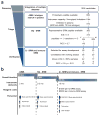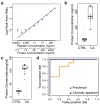A targeted proteomics-based pipeline for verification of biomarkers in plasma
- PMID: 21685906
- PMCID: PMC3232032
- DOI: 10.1038/nbt.1900
A targeted proteomics-based pipeline for verification of biomarkers in plasma
Abstract
High-throughput technologies can now identify hundreds of candidate protein biomarkers for any disease with relative ease. However, because there are no assays for the majority of proteins and de novo immunoassay development is prohibitively expensive, few candidate biomarkers are tested in clinical studies. We tested whether the analytical performance of a biomarker identification pipeline based on targeted mass spectrometry would be sufficient for data-dependent prioritization of candidate biomarkers, de novo development of assays and multiplexed biomarker verification. We used a data-dependent triage process to prioritize a subset of putative plasma biomarkers from >1,000 candidates previously identified using a mouse model of breast cancer. Eighty-eight novel quantitative assays based on selected reaction monitoring mass spectrometry were developed, multiplexed and evaluated in 80 plasma samples. Thirty-six proteins were verified as being elevated in the plasma of tumor-bearing animals. The analytical performance of this pipeline suggests that it should support the use of an analogous approach with human samples.
Conflict of interest statement
The authors declare no competing financial interests.
Figures




Comment in
-
Streamlining biomarker discovery.Nat Biotechnol. 2011 Jul 11;29(7):600-2. doi: 10.1038/nbt.1917. Nat Biotechnol. 2011. PMID: 21747385 No abstract available.
Similar articles
-
Streamlining biomarker discovery.Nat Biotechnol. 2011 Jul 11;29(7):600-2. doi: 10.1038/nbt.1917. Nat Biotechnol. 2011. PMID: 21747385 No abstract available.
-
A pipeline that integrates the discovery and verification of plasma protein biomarkers reveals candidate markers for cardiovascular disease.Nat Biotechnol. 2011 Jun 19;29(7):635-43. doi: 10.1038/nbt.1899. Nat Biotechnol. 2011. PMID: 21685905 Free PMC article.
-
Identification of multiple novel protein biomarkers shed by human serous ovarian tumors into the blood of immunocompromised mice and verified in patient sera.PLoS One. 2013;8(3):e60129. doi: 10.1371/journal.pone.0060129. Epub 2013 Mar 27. PLoS One. 2013. PMID: 23544127 Free PMC article.
-
Protein biomarker discovery and validation: the long and uncertain path to clinical utility.Nat Biotechnol. 2006 Aug;24(8):971-83. doi: 10.1038/nbt1235. Nat Biotechnol. 2006. PMID: 16900146 Review.
-
The bottleneck in the cancer biomarker pipeline and protein quantification through mass spectrometry-based approaches: current strategies for candidate verification.Clin Chem. 2010 Feb;56(2):212-22. doi: 10.1373/clinchem.2009.127019. Epub 2009 Dec 10. Clin Chem. 2010. PMID: 20007861 Review.
Cited by
-
Targeted multiplexed selected reaction monitoring analysis evaluates protein expression changes of molecular risk factors for major psychiatric disorders.Int J Neuropsychopharmacol. 2014 Oct 31;18(1):pyu015. doi: 10.1093/ijnp/pyu015. Int J Neuropsychopharmacol. 2014. PMID: 25539505 Free PMC article.
-
Development of a Targeted Urine Proteome Assay for kidney diseases.Proteomics Clin Appl. 2016 Jan;10(1):58-74. doi: 10.1002/prca.201500020. Epub 2015 Oct 6. Proteomics Clin Appl. 2016. PMID: 26220717 Free PMC article.
-
An Integrated Quantitative Proteomics Workflow for Cancer Biomarker Discovery and Validation in Plasma.Front Oncol. 2020 Sep 23;10:543997. doi: 10.3389/fonc.2020.543997. eCollection 2020. Front Oncol. 2020. PMID: 33072574 Free PMC article.
-
Total ApoE and ApoE4 isoform assays in an Alzheimer's disease case-control study by targeted mass spectrometry (n=669): a pilot assay for methionine-containing proteotypic peptides.Mol Cell Proteomics. 2012 Nov;11(11):1389-403. doi: 10.1074/mcp.M112.018861. Epub 2012 Aug 23. Mol Cell Proteomics. 2012. PMID: 22918225 Free PMC article.
-
Intraventricular B7-H3 CAR T Cells for Diffuse Intrinsic Pontine Glioma: Preliminary First-in-Human Bioactivity and Safety.Cancer Discov. 2023 Jan 9;13(1):114-131. doi: 10.1158/2159-8290.CD-22-0750. Cancer Discov. 2023. PMID: 36259971 Free PMC article.
References
-
- Anderson NL. The clinical plasma proteome: a survey of clinical assays for proteins in plasma and serum. Clin Chem. 2010;56:177–185. - PubMed
-
- Haab BB, et al. A reagent resource to identify proteins and peptides of interest for the cancer community: a workshop report. Mol Cell Proteomics. 2006;5:1996–2007. - PubMed
-
- Stoevesandt O, Taussig MJ. Affinity reagent resources for human proteome detection: initiatives and perspectives. Proteomics. 2007;7:2738–2750. - PubMed
Publication types
MeSH terms
Substances
Grants and funding
LinkOut - more resources
Full Text Sources
Other Literature Sources

